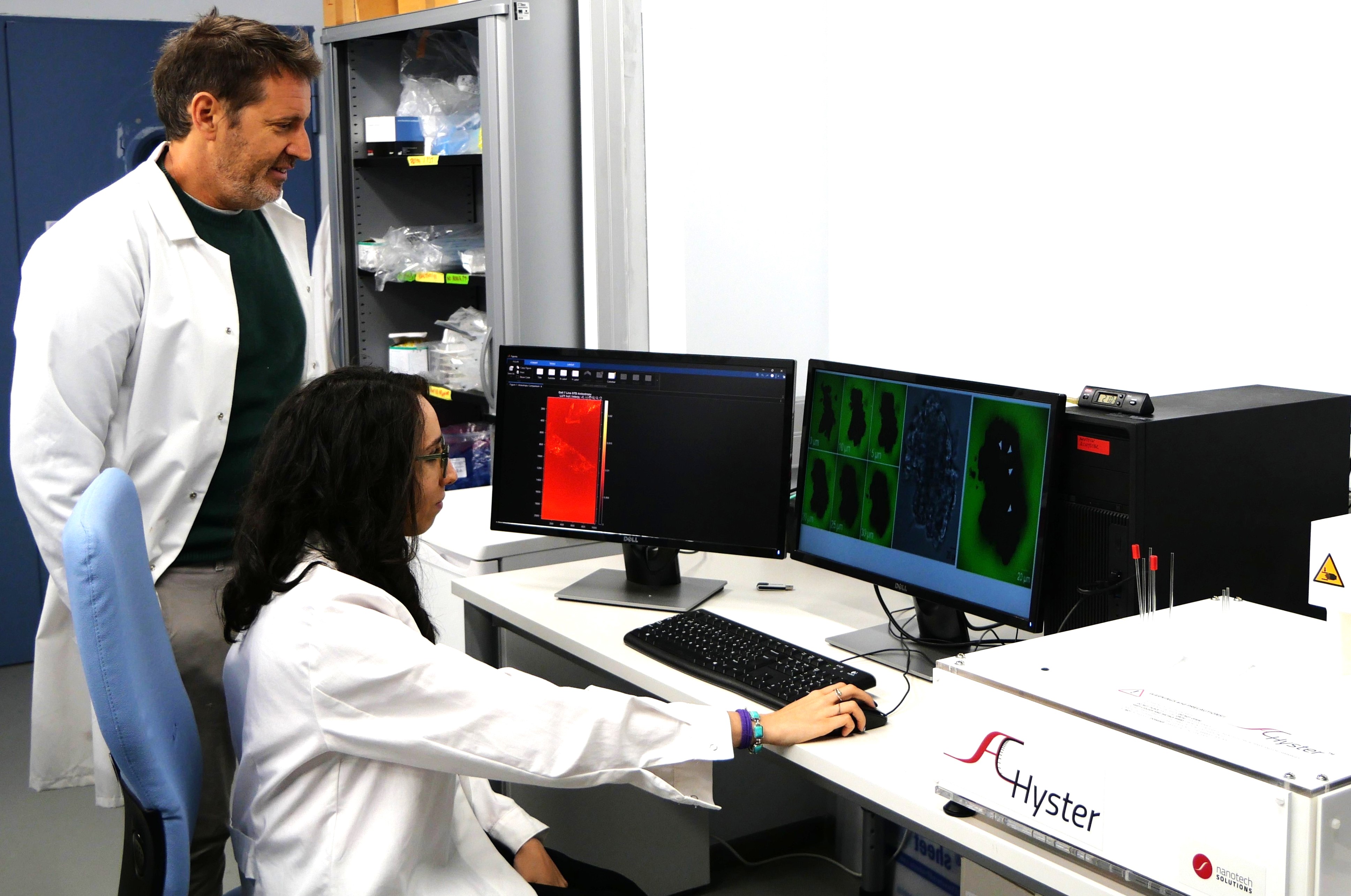IMDEA Nanociencia researchers develop an innovative technique to destroy cancer cell inducing a ‘cascade’ that spreads throughout the tumour
04.11.2025
 |
|
A group of tumour cells is irradiated with a beam of light. Image: inmywork for IMDEA Nanociencia. |
- The strategy allows cancer cells to be selectively destroyed by irradiating a single cell with a laser.
- When applied to 3D tumor models, the effect propagates to adjacent cells, inducing cell death in the core of the tumor and progressively extending throughout its structure.
| Tweet |
Madrid, 4th November, 2025. Photodynamic therapy is a clinically approved cancer treatment that relies on light irradiation of tumour areas where a photosensitizing agent has been previously administered. Light activation releases toxic compounds aimed at inducing the death of cancer cells. Typically, irradiation is applied to the entire tumour. Researchers at the IMDEA Nanociencia institute propose an innovative approach: focused laser irradiation on individual tumour cells.
Using clinically approved photosensitizing agents, the researchers demonstrated that focused laser irradiation causes selective damage to cancer cells in culture. By irradiating with a pinpoint light, the cell membrane was perforated, inducing the death of the targeted cell with high precision. Within less than a minute, the researchers were able to observe cell death in real time under a microscope.
The most striking aspect of this study was the observation that the effect extended to adjacent cells. To investigate this, the researchers used tumour spheroids—3D cell cultures that mimic the actual organization of cells in tumours. Cells within the spheroid were irradiated, and for the first time, it was observed that neighbouring non-irradiated cells also died due to the so-called “bystander effect.” The bystander effect is a phenomenon previously described in radiotherapy and also observed in photodynamic therapies, where stress signals from a damaged cell induce the death of neighbouring non-irradiated cells. The researchers observed that, after the pinpoint light irradiation, cell death spread throughout the entire tumour spheroid in culture within 10 minutes.
 Dr. Sebastián Thompson, the study’s lead author, expressed great enthusiasm: “The fact that we present this proof of concept using both markers and light already used clinically opens up an immense range of applications, since only the method of irradiating the tumour changes. This creates a much more favourable scenario for future tests in animal models. Photodynamic therapy is already in clinical use, and in the areas where it is applied—lung cancer, brain tumours, etc.—it could potentially support future applications.” He added: “With this technique, we are inducing cell death from within the tumour spheroid, a scenario as counterintuitive as it is fascinating. For this reason, we are also theoretically investigating this phenomenon, which we have explored experimentally.” Cristina Carrizo, the study’s first author, highlighted the next steps: “The next steps will be to determine the limits of the bystander effect, ensure healthy cells are not damaged, and identify the tumour sizes to which this new technique could be applied to define future tests in animal models.”
Dr. Sebastián Thompson, the study’s lead author, expressed great enthusiasm: “The fact that we present this proof of concept using both markers and light already used clinically opens up an immense range of applications, since only the method of irradiating the tumour changes. This creates a much more favourable scenario for future tests in animal models. Photodynamic therapy is already in clinical use, and in the areas where it is applied—lung cancer, brain tumours, etc.—it could potentially support future applications.” He added: “With this technique, we are inducing cell death from within the tumour spheroid, a scenario as counterintuitive as it is fascinating. For this reason, we are also theoretically investigating this phenomenon, which we have explored experimentally.” Cristina Carrizo, the study’s first author, highlighted the next steps: “The next steps will be to determine the limits of the bystander effect, ensure healthy cells are not damaged, and identify the tumour sizes to which this new technique could be applied to define future tests in animal models.”
In summary, the study presents a new technique within photodynamic therapy that uses clinically approved photosensitizing agents and can destroy tumour spheroids from the inside in a highly precise, cell-by-cell manner. This new concept in photodynamic therapy could be combined with other therapies or surgeries to help achieve complete cancer eradication. The study opens new perspectives in the fight against aggressive tumours such as glioblastoma, achieving highly selective and efficient treatment. The results suggest that this single-point photodynamic therapy could become a promising complement to current oncological treatments.
This work was conceived at IMDEA Nanoscience and the CNB-CSIC. It received co-financing from the Spanish Association Against Cancer and the Severo Ochoa Excellence accreditation to IMDEA Nanociencia (CEX2020-001039-S).
Reference:
C. S. Carrizo, J. Fernández de Córdoba, A. Oña, G. D'Agostino, and S. A. Thompson, “ Single-Point Laser Irradiation Photodynamic Therapy: From Selective Plasma Damaging to Cell Death from Within the Tumor.” Adv. Therap. (2025): e00541. https://doi.org/10.1002/adtp.202400541
![]() Link to IMDEA Nanociencia Repository: https://hdl.handle.net/20.500.12614/4150
Link to IMDEA Nanociencia Repository: https://hdl.handle.net/20.500.12614/4150
Contact:
Sebastian Thompson
Intracellular Temperature Measurements Group
https://nanociencia.imdea.org/intracellular-temperature-measurements/home
IMDEA Nanociencia Dissemination and Communication Office
divulgacion.nanociencia [at]imdea.org![]()
![]()
![]()
![]()
![]()
Source: IMDEA Nanociencia.
IMDEA Nanociencia Institute is a young interdisciplinary research Centre in Madrid (Spain) dedicated to the exploration of nanoscience and the development of applications of nanotechnology in connection with innovative industries.




